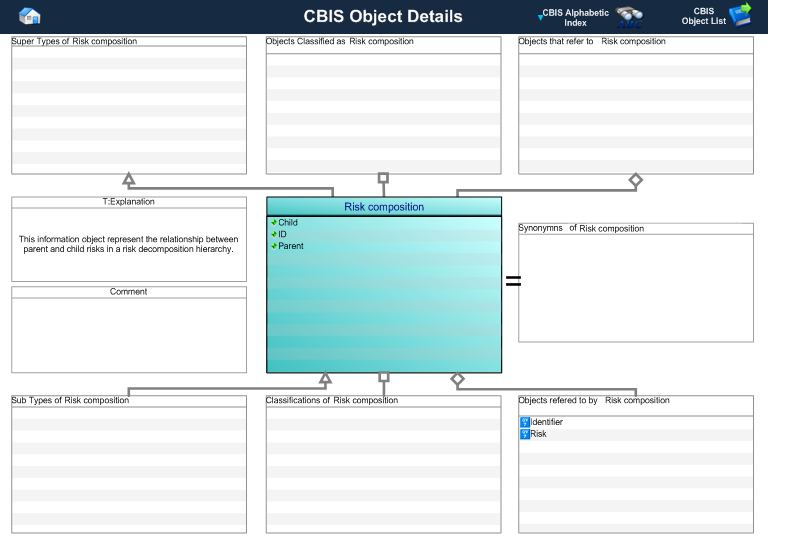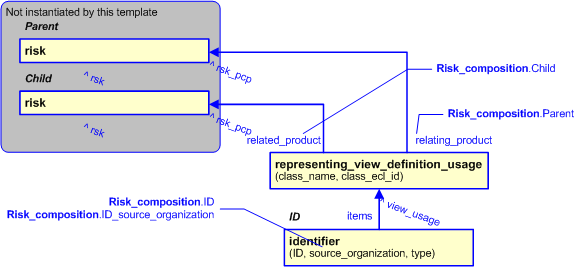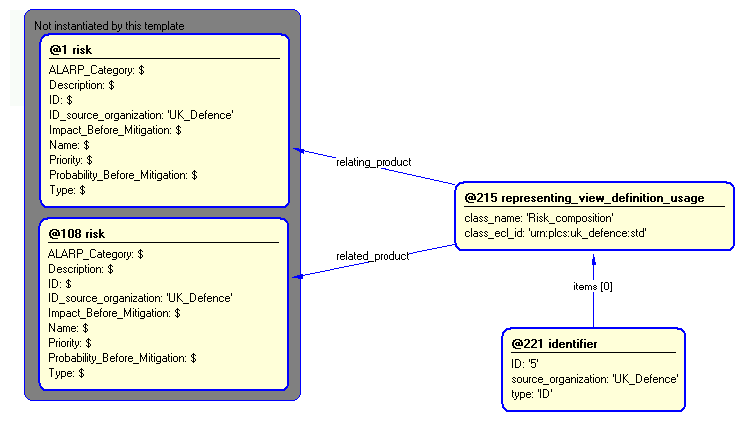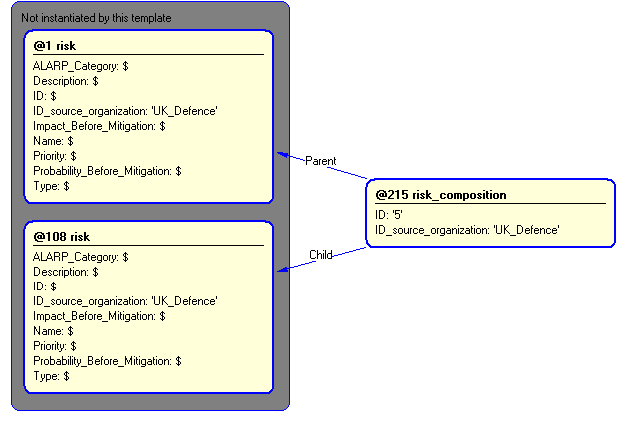Template:— risk_composition (rsk_cmp)
Context:— UK_Defence |
Date: 2010/03/15 15:08:44
Revision: 1.3
|
This section specifies the template risk_composition.
NOTE
The template has been defined in the context of
UK_Defence.
Refer to the business context for details of related templates.
NOTE
An explanation of a template and the associated instantiation path is
provided in the
Template overview
section.
This template describes how to represent a risk composition.
A risk_composition represent the relationship between parent and child risks in a risk decomposition hierarchy.
This information object represent the relationship between parent and child risks in a risk decomposition hierarchy.
Figure 1 — A MOOD Business Architect representation of the Business Object: Risk composition
The attributes of the Risk composition object are tabled below.
|
Attribute name
|
Attribute description
|
Attribute type
|
Optionality
|
| Child |
This is the reference to the child risk in the decomposition hierarchy. |
Risk |
Mandatory |
| ID |
This is the identifier of the risk composition. |
Identifier |
Mandatory |
| Parent |
This is the reference to the parent risk in the decomposition hierarchy. |
Risk |
Mandatory |
Table 1 — Risk composition attribute details
NOTE
This template is dependent on entities in the ISO10303-239 Edition 2 schema.
The EXPRESS-G diagram in
Figure
2
shows the templates and EXPRESS entities that are required
to represent the template
"risk_composition".
The text highlighted in blue shows the template parameters.
Figure 2 — An EXPRESS-G representation of the Information model for risk_composition
The graphic for the template to be used in other EXPRESS-G diagrams
is shown in Figure
3
below.
Figure 3 — The graphical representation of the risk_composition template
The following input parameters are defined for this template:
Child (Type=
'ENTITY
(
![[warning:]]() Error ER1: The entity Risk_perception does not exist
Error ER1: The entity Risk_perception does not existRisk_perception)'
![[warning:]]() Error EXP-1: The EXPRESS entity Risk_perception
Error EXP-1: The EXPRESS entity Risk_perception
does not exist in data/schemas/ap239_arm_lf.xml.)
This is the "As Low As Reasonably Practicable" ALARP category of the risk.
This is the identifier of the risk.
The organization that created the associated identifier. Additionally
a Person or Information System could be defined when either of these are the source; see Identifier template characterizations
Parent (Type=
'ENTITY
(
![[warning:]]() Error ER1: The entity Risk_perception does not exist
Error ER1: The entity Risk_perception does not existRisk_perception)'
![[warning:]]() Error EXP-1: The EXPRESS entity Risk_perception
Error EXP-1: The EXPRESS entity Risk_perception
does not exist in data/schemas/ap239_arm_lf.xml.)
This is the impact of the risk before mitigation.
The instantiation path shown below specifies the entities that are to be
instantiated by the template.
A description of templates and the syntax for the instantiation path is
provided in the
Templates Help/Information section.
/
representing_view_definition_usage(
related_product=@Child,
relating_product=@Parent,
class_name='Risk_composition',
class_ecl_id='urn:plcs:rdl:uk_defence')/
-- ID /
identifier(
ID=@ID,
source_organization=@ID_source_organization,
type='ID',
items=$representing_view_definition_usage.view_usage)/
The instance diagram in Figure
4
shows an example of the EXPRESS entities and templates that are instantiated by the template:
/risk_composition(Child='#108', ID='5', ID_source_organization='UK_Defence', Parent='#1')/
(an illustration of the consolidated risk_composition template is shown in
Figure
5 below.)
Figure 4 — Entities instantiated by risk_composition template
The instance diagram in
Figure
5
shows the graphic symbol for the template that is to be
used in other instance diagrams. The example template is:
/risk_composition(Child='#108', ID='5', ID_source_organization='UK_Defence', Parent='#1')/
Figure 5 — Instantiation of risk_composition template
Characterizations
No common characterizations of the template
risk_composition
have been identified. However, the ISO 10303-239 EXPRESS model
may enable other assignments to the entities instantiated by the template.




